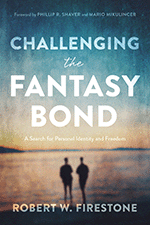Fantasy Bond 101
 This month, I’ve been working on creating a whiteboard explaining the fantasy bond and I’ve come to realize that it is a complex concept to get across in only a few words and with simple drawings. A while ago, I did a whiteboard about the critical inner voice, which was also challenging to describe. What should the critical inner voice look like? What are the attacks that most people could relate to? But it was a fun challenge. Now I’m wrestling with a concept that is even trickier to convey. So, the purpose of this blog is twofold: to organize my thoughts as I explain the fantasy bond to you in a clear and simple way.
This month, I’ve been working on creating a whiteboard explaining the fantasy bond and I’ve come to realize that it is a complex concept to get across in only a few words and with simple drawings. A while ago, I did a whiteboard about the critical inner voice, which was also challenging to describe. What should the critical inner voice look like? What are the attacks that most people could relate to? But it was a fun challenge. Now I’m wrestling with a concept that is even trickier to convey. So, the purpose of this blog is twofold: to organize my thoughts as I explain the fantasy bond to you in a clear and simple way.
First off, it’s necessary to clarify that this specific use of the word “bond” is different from its other uses in psychology and the popular culture. It does not refer to “bond” in a positive sense, as in the healthy “bonding” of parent-infant attachment, nor does it refer to the closeness of a relationship that includes loyalty, devotion and love. The concept of the fantasy bond uses “bond” in the sense of bondage or a limitation of freedom.
The fantasy bond is a largely unconscious psychological defense that is formed in childhood and expanded and maintained throughout one’s life. In essence, it is an imaginary connection, an illusion of being merged with another person, social group or cause. This fantasy of fusion offers relief from emotional distress and anxiety, and provides a false sense of security and safety.
THE ORIGINAL FANTASY BOND
The fantasy bond is formed early in life when an infant suffers from the emotional distress of not having their needs met by a parent or caretaker. In his new book, Challenging the Fantasy Bond, Robert Firestone describes the baby’s situation, “The infant, lacking any sense of time, knows only the intensity of the moment and suffers intolerable fear and emotional pain when faced with frustration and separation anxiety.” To allay those feelings, a baby develops an illusion of connection or merged identity with their parent.
This imagination provides the baby with partial gratification of their emotional and physical needs, easing their anxiety and soothing their distress. In other words, the fantasy bond serves as a substitute for love and care at those times when it is missing in the infant’s early environment.
The fantasy bond is reinforced during those times when a parent is especially insensitive, neglectful, hostile, outright angry or abusive. These incidents occur during the parents’ worst moments, during which the child perceives the parent as being threatening. Maintaining the fantasy bond requires the child to create an idealized image of the parents as always good and capable. This reduces the anxiety in relation to parental neglect or abuse and to some extent also helps to minimize and deny the very reality of it. Unfortunately, to preserve this idealization, the child develops a corresponding negative self-image. In other words, to keep the parent good, they must view themselves as bad.
THE FANTASY BOND IN A ROMANTIC RELATIONSHIP
As a romantic relationship develops and becomes more meaningful, each person feels increased anxiety from being vulnerable and open to their partner. They are drawn to being close and intimate, but they are also afraid and self-protective. People often resolve this conflict by moving away from love and establishing a fantasy bond with each other. They form an imaginary unit, and gradually substitute a fantasy of love for genuine affection and closeness. As with the original fantasy bond, the fantasy bond within the couple acts as a defense to ease anxiety and insecurity. However, to the extent that they form a bond, people become emotionally cut off from their own feelings and insensitive to those of their partner.
THE FANTASY BOND IN SOCIETY
As individuals develop, the fantasy bond is extended to family members, romantic partners, authority figures and social groups. While the imagined connection offers a temporary respite from stress, separation anxiety, and death fears, it tends to be maladaptive in life and interferes with a person’s movement toward individuation and autonomy. Robert Firestone writes, “Existential dread impels us to form illusory connections, hoping to recapture the infantile sense of safety, security and omnipotence provided by the original fantasy bond. We are subconsciously looking to a significant person or other external source to guarantee us immortality much as we imagined our parent could. The fantasy bond that was formed originally to cope with separation anxiety becomes a defense against death anxiety.”
On a societal level, the feelings of security achieved by identifying with a specific group or cause provide a person with a sense of belonging, but at the same time, the fantasy bond predisposes alienation and fear of those who have different beliefs and worldviews. This perpetuates the hostile divide and long-standing animosities that are predominant between peoples of different countries and ethnicities throughout the world.
THE CRITICAL INNER VOICE & THE FANTASY BOND
The critical inner voice is the language of the defensive process. It is a system of thoughts that undermines the self and is disparaging and hostile toward others. It reinforces the split between the idealization of the parent and the corresponding negative view of the self. It encourages behaviors that are not in a person’s best interests, for example egging a person on, “Go ahead, have one more drink.” And then afterward, “You have no will power! You are just a loser.” Or in relation to others, “Don’t bother trying to get to know them, they’re kind of snooty anyway.” In all of these instances, being aware of the critical inner voice is helpful in challenging the process of the fantasy bond.
In relation to the fantasy bond between the couple, the critical inner voice attacks the person, “You’re ugly. They can’t really be attracted to you,” their partner, “They’re just using you, don’t trust them,” their relationship, “You two are making fools of yourselves,” and love in general, “Love never lasts!” In relation to the fantasy bond within a group, the critical inner voice is divisive and fosters paranoia, “Your family/group/team is better than the others.” Or, “Those other people are different and strange. They could be dangerous.”
Becoming aware of the process of fantasy bond and the critical inner voice enables us to identify the ways we have turned against our own desires and priorities and allows us to take back control of our lives. When we recognize the voice process as an enemy within that is offering bad advice, we can become aware of how it promotes attitudes that support the fantasy bond. We can then recognize the influence these voices have on our actions and begin to change our behaviors.
Taking concrete steps to challenge the fantasy bond empowers us to move beyond the attitudes and actions that have kept us from living our best, most authentic, lives. Freeing ourselves from these predetermined points of view allows for more personal relating with others, including the sharing of humor, affection and other intimacies that may have alluded us before.
See more from the book Challenging the Fantasy Bond
 Tags: challenging the fantasy bond, child development, critical inner voice, defenses, development, emotional development, fantasy bond, fantasy in relationships, inner critic, parenting, problems in relationships, psychological defenses, relationship with parents, relationships, robert firestone, security, self-esteem, sense of self
Tags: challenging the fantasy bond, child development, critical inner voice, defenses, development, emotional development, fantasy bond, fantasy in relationships, inner critic, parenting, problems in relationships, psychological defenses, relationship with parents, relationships, robert firestone, security, self-esteem, sense of self
One Comment
Comments are closed.










Tamsen, I appreciated your writing this post. It clarifies the Fantasy Bond and also broadens how it impacts our society at large-beyond our intimate relationships. Thanks